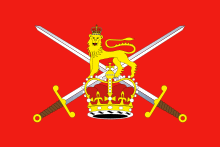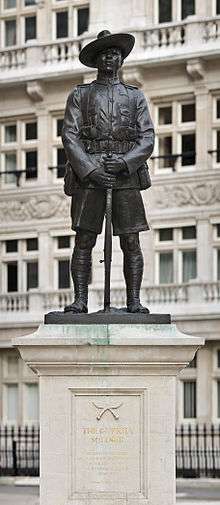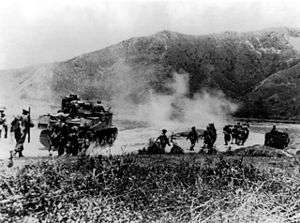Brigade of Gurkhas
 |
| Arms of the British Army |
|---|
| Combat Arms |
|
|
| Combat Support Arms |
| Combat Services |
|
|
Brigade of Gurkhas is the collective name which refers to all the units in the British Army that are composed of Nepalese soldiers. The brigade, which is 3,640 strong, draws its heritage from Gurkha units that originally served in the Indian Army prior to Indian independence, and prior to that served for the East India Company. The brigade includes infantry, engineering, signal, logistic and training and support units. They are famous for their kukris, a distinctive heavy knife with a curved blade, and have a reputation for being fierce and brave soldiers. They take their name from the hill town of Gorkha from which the Nepalese Kingdom had expanded. The ranks have been dominated by four ethnic groups: the Gurungs and Magars from western Nepal, and the Rais and Limbus, who live in hill villages, from the east.
The Brigade celebrated 200 years of service in the British Army in 2015.[1][2]
Origins
During the war in Nepal in 1814, in which the British attempted to annex Nepal into the Empire, Army officers were impressed by the tenacity of the Gurkha soldiers and encouraged them to volunteer for the East India Company. Gurkhas served as troops of the Company in the Pindaree War of 1817, in Bharatpur, Nepal in 1826, and the First and Second Sikh Wars in 1846 and 1848. During the Sepoy Mutiny in 1857, the Gurkha regiments remained loyal to the British, and became part of the British Indian Army on its formation. The 2nd Gurkha Rifles (The Sirmoor Rifles) and the 60th Rifles famously defended Hindu Rao's house.[3]
History
During the Malayan Emergency in the late 1940s, Gurkhas fought as jungle soldiers as they had done in Burma.[4] The Training Depot Brigade of Gurkhas was established on 15 August 1951 at Sungai Petani, Kedah, Malaya.[5] After the conflict ended, the Gurkhas were transferred to Hong Kong, where they carried out security duties.[5] The troops patrolled the border checking for illegal immigrants entering the territory, most crucially during the turbulence of the Cultural Revolution. They were deployed to contain crowds during the Star Ferry riots of 1966. After Indian independence and partition in 1947, under the Tripartite Agreement, six Gurkha regiments joined the post-independence Indian Army. Four Gurkha regiments, the 2nd, 6th, 7th, and 10th Gurkha Rifles, joined the British Army on 1 January 1948.[6] The 1st/2nd Gurkha Rifles was deployed to Brunei at the outbreak of the Brunei Revolt in 1962.[7] In 1974 Turkey invaded Cyprus and the 10th Gurkha Rifles was sent to defend the British sovereign base area of Dhekelia.[8] On 1 July 1994 the four rifle regiments were merged into one, the Royal Gurkha Rifles, and the three corps regiments (the Gurkha Military Police having been disbanded in 1965) were reduced to squadron strength. On 1 July 1997, the British government handed Hong Kong over to the People's Republic of China, which led to the elimination of the local British garrison. Gurkha HQ and recruit training were moved to the UK.[5] The Royal Gurkha Rifles took part in operations in Kosovo in 1999, in UN peacekeeping operations in East Timor in 2000 and in Sierra Leone later that year.[9]

In 2007 the Brigade of Gurkhas announced that women were allowed to join.[10] Like their British counterparts, Gurkha women are eligible to join the Engineers, Logistics Corps, Signals and the brigade band, although not infantry units.[11] In September 2008 the High Court in London ruled that the British Government must issue clear guidance on the criteria against which Gurkhas may be considered for settlement rights in the UK. On 21 May 2009, and following a lengthy campaign by Gurkha veterans, the British Home Secretary, Jacqui Smith, announced that all Gurkha veterans who had served four years or more in the British Army before 1997 would be allowed to settle in Britain.[12]
British Gurkha units 1947–1994
Former units included:[6]
- 2nd King Edward VII's Own Gurkha Rifles (1947–1994)
- 6th Queen Elizabeth's Own Gurkha Rifles (1947–1994)
- 7th Duke of Edinburgh's Own Gurkha Rifles (1947–1994)
- 10th Princess Mary's Own Gurkha Rifles (1947–1994)
- Gurkha Army Service Corps (1958–1965)
- Gurkha Transport Regiment (1965–1992)
- Queen's Gurkha Engineers (1977–present)
- Gurkha Engineer Training Squadron, Royal Engineers (1948–1951)
- 50th (Gurkha) Engineer Regiment, Royal Engineers (1951–1955)
- Gurkha Engineers (1955–1977)
- Queen's Gurkha Signals (1977–present)
- Gurkha Signals (1948–1949)
- Gurkha Royal Signals (1949–1954)
- Gurkha Signals (1954–1977)
- Gurkha Provost Company, Royal Military Police (1949–1957)
- 17th Gurkha Divisional Provost Company, Royal Military Police (1957–1969)
- Gurkha Independent Parachute Company, Parachute Regiment (c. 1960–1970)
The Brigade of Gurkhas today
Today, over 2000 Gurkhas are recruited by the British Army for the Gurkha Contingent of the Singapore Police Force. Approximately 2,000 Gurkhas serve a similar role in the Gurkha Reserve Unit in Brunei.[13] In addition to the British Army, Gurkhas are also recruited by the Indian Army (approximately 100,000 in 44 battalions plus 25 battalions of Assam Rifles), as part of the tripartite agreement that was signed at the time of India's independence. This is further documented in a list of Gurkha regiments serving under the Indian Army.[14]
Current units of the Brigade of Gurkhas include:[15]
- HQ, Brigade of Gurkhas, based at Royal Military Academy Sandhurst, Surrey
- British Gurkhas Nepal
- 1st and 2nd Battalions, The Royal Gurkha Rifles
- The Queen's Gurkha Engineers based within 36 Engineer Regiment, Invicta Park Barracks, Maidstone
- The Queen's Gurkha Signals, based in York, Bramcote, Blandford and Stafford. There are additional Troop locations in Nepal and Brunei.
- 10 Queen's Own Gurkha Logistic Regiment RLC, based at Aldershot Garrison.[16]
- Gurkha Staff and Personnel Support Company
- The Band of the Brigade of Gurkhas
- Gurkha Company, 3rd Battalion, Infantry Training Centre, Catterick
- The Gurkha Company (Sitang), Royal Military Academy Sandhurst
- The Gurkha Company (Mandalay), Infantry Battle School, Brecon
- Brigade of Gurkhas Training Team
- Gurkha Language Wing, Catterick
Recruitment and basic training
The selection process for the Gurkhas is very demanding: only 230 trainee riflemen are recruited each year out of about 17,000 applicants in the British army.[17] Gurkhas training lasts for 36 weeks and addresses a range of areas such as the Brigade ethos, language training, cultural training, career management and trade selection, as well the same 26-week Combat Infantryman's Course that the Line Infantry receive. This enables the trained Gurkha soldiers to fulfill their roles on operations and continue the great traditions of their forefathers.[18]
Organisation
Brigade HQ is based at Royal Military Academy Sandhurst, Surrey. The two battalions of the Royal Gurkha Rifles are formed as light role infantry; they are not equipped with either armoured or wheeled vehicles.[19] The First Battalion Royal Gurkha Rifles is based at the British garrison in Brunei as part of Britain's commitment to maintaining a military presence in SE Asia.[20] The Second Battalion Royal Gurkha Rifles is based at Shorncliffe Army Camp, near Folkestone in Kent as part of 16 Air Assault Brigade, and is available for deployment to most areas in Europe and Africa.
Commemoration of service
London memorial

The British memorial to the Gurkhas was unveiled by Queen Elizabeth II on 3 December 1997. The inscription on the monument is a quotation from Sir Ralph Turner, a former officer in the 3rd Gurkha Rifles.
200 years of service
A series of events took place in 2015 to mark 200 years of service by the Gurkhas in the British Army including a march past Buckingham Palace.[21][22][23]
Other
Under international law, according to Protocol 1 Additions to the Geneva Conventions of 1949, Gurkhas serving as regular uniformed soldiers are not mercenaries.[24] According to Cabinet Office official histories (Official History of the Falkland Islands, Sir Lawrence Freedman), Sir John Nott, as Secretary of State for Defence, expressed the British Government's concern that the Gurkhas could not be sent with the task force to recapture the Falkland Islands because it might upset the non-aligned members of the fragile coalition of support that the British had built in the United Nations. The then Chief of Defence Staff Sir Edwin Bramall, a former officer in the 2nd Gurkhas like Nott, said that the Gurkhas were needed for sound military reasons (as a constituent part of 5th Infantry Brigade) and if they were not deployed then there would always be a political reason not to deploy Gurkhas in future conflicts. So he requested that Nott argue the case in Government for deploying them against the advice of the Foreign Office. Nott agreed to do so, commenting that the Gurkhas "would be mortified if we spoilt their chances [of going]".[25]
Alliances
-
 Australia – The Royal Australian Regiment
Australia – The Royal Australian Regiment -
 New Zealand – The Royal New Zealand Infantry Regiment
New Zealand – The Royal New Zealand Infantry Regiment -
 Brunei – The Royal Brunei Land Forces
Brunei – The Royal Brunei Land Forces
See also
- French Foreign Legion
- Queen's Truncheon
- Gorkha regiments (India)
- Gurkha Contingent (Singapore Police Force)
- Modern equipment and uniform of the British Army
References
- ↑ "200th anniversary of the Gurkhas: fierce, loyal and brave, Britain must thank them for their service". The Telegraph. 7 April 2015. Retrieved 22 May 2015.
- ↑ "Nepali men have been fighting for Britain for 200 years". The Washington Post. 30 April 2015. Retrieved 23 May 2015.
- ↑ "Artist captures key moment of Gurkha loyalty". The Telegraph. 2 September 2001. Retrieved 16 May 2014.
- ↑ "Operations by 1st Battalion 6th Gurkha Rifles during the Malayan Emergency". Retrieved 16 May 2014.
- 1 2 3 "The Nepalese community in Hong Kong looks to preserve Gurkha legacy". Lifestyle. Retrieved 16 May 2014.
- 1 2 "The Gurkha Museum Winchester". Retrieved 15 May 2014.
- ↑ "British officer served with 1/2nd Gurkha Rifles in Brunei Rebellion, 1962-1963". Imperial War Museum. Retrieved 16 May 2014.
- ↑ "A short history of the 10th Princess Mary's own Gurkha Rifles". Retrieved 16 May 2014.
- ↑ "The Royal Gurkha Rifles: Regimental History". Retrieved 16 May 2014.
- ↑ "Women set to join the Gurkhas". The Guardian. 24 June 2007. Retrieved 15 May 2014.
- ↑ Page, Jeremy (16 June 2007). "Women prove they are fit to make history with Gurkhas". The Times. London.
- ↑ "Gurkhas win right to settle in UK". BBC News. 21 May 2009. Retrieved 24 May 2009.
- ↑ Brunei Darussalam, Encyclopedia of the Nations Archived March 1, 2016, at the Wayback Machine.
- ↑ Nepal Gurkhas Serving Abroad Archived March 3, 2016, at the Wayback Machine. The source given in the article is "The Library of Congress Country Studies; CIA World Factbook"
- ↑ "Serving Brigade of Gurkhas". Retrieved 15 May 2014.
- ↑ Royal Visit For 50 year old Gurkha Regiment. The national archives. Retrieved 12 February 2012
- ↑ "Gurkhas: recruiting". Retrieved 16 May 2014.
- ↑ "The British Army - Gurkha training". www.army.mod.uk. Retrieved 2016-10-27.
- ↑ "The Gurkha culture". Ministry of Defence. Retrieved 16 May 2014.
- ↑ "Royal Gurkha Rifles". Ministry of Defence. Retrieved 16 May 2014.
- ↑ "Events". Gurkha 200. Retrieved 22 May 2015.
- ↑ "Gurkhas march to remember fallen comrades". BBC News. 30 April 2015. Retrieved 22 May 2015.
- ↑ "Gurkha 200". Gurkha Welfare Trust. Retrieved 23 May 2015.
- ↑ Wither, James (January 2005). "Expeditionary Forces for Post Modern Europe: Will European Military Weakness Provide an Opportunity for the New Condottieri?". Conflict Studies Research Centre, website of the MoD. p. 11. Archived from the original on 21 October 2007.
- ↑ Freedman, Lawrence, (2005). The Official History of the Falklands Campaign, Volume 2: War and Diplomacy, Routledge, ISBN 978-0-7146-5207-8. Page 208.
Further reading
- Parker, John (1999). The Gurkhas. Headline Book Publishing. ISBN 0-7472-6243-8.
External links
| Wikimedia Commons has media related to Brigade of Gurkhas. |
- Brigade of Gurkhas—on British Army official website
- The Band of the Brigade of Gurkhas—official website
- 36 Engineer Regiment (home of Queens Gurkha Engineers)
- Gurkha Museum
- "Brigade of Gurkhas" in Land Forces of Britain, The Empire and Commonwealth
- Gray, Denis D. (Associated Press Writer) (17 May 2008). "Imperial holdover: Gurkhas flock to British army". USA Today.
- King, Hannah (8 January 2015). "Army Welcomes Latest Gurkha Recruits". British Forces News Service. Archived from the original on 2015-02-22. Video of new recruits from Nepal arriving at the Catterick Garrison
